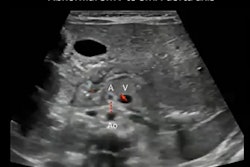
Traditional ultrasound surveillance may give a false sense of security when examining children undergoing imaging of the urinary tract, but adding urodynamic ultrasound can help, according to a pilot study published August 21 in Urology.
Researchers led by Dr. Devon Snow-Lisy from Swedish Pediatric Specialty Care in Seattle found that despite instructions to the contrary, most patients do not come for such surveillance with full bladders, which means less accurate measurements of the upper urinary tract.
"Our data demonstrates that traditional ultrasound for surveillance is insufficient in that it commonly underestimates the upper tract dilation that our most vulnerable patients experience," the team wrote. "We found urodynamic ultrasound to be advantageous due to the ability to image the bladder, ureters, and kidney in real-time."
Surveillance renal and bladder ultrasounds are typically used to measure the degree of dilation of the upper urinary tract in children, where the area of the kidney in which urine is collected is enlarged. These measurements can be in turn used clinically to see how effective current bladder management in children is, and adjustments can be made from there.
However, bladder volumes can influence the severity of upper tract dilation, making bladder management challenging. Families are instructed to have their child come in with a full bladder, so the ultrasound reflects the dilation that the kidneys may regularly experience.
"Unfortunately, maximal bladder distension is not consistently achieved at the time of ultrasound," the researchers said. "Prevention of upper tract damage is one of the top priorities in the management of a patient with bladder dysfunction."
The team wanted to see if combining traditional ultrasound surveillance at the time of integrated urodynamic ultrasound would allow for evaluation of dilation at bladder capacity. They also wanted to see how much traditional ultrasound underestimates dilation at bladder capacity.
The researchers looked at 10 pediatric patients ages 5 or younger who underwent same-day traditional ultrasound and integrated urodynamic ultrasound.
They found that bladder volume on traditional ultrasound was 180 mL, significantly smaller than final bladder volume on urodynamic ultrasound at 363 mL (p < 0.001). Upper tract dilation was upgraded in 25% of kidneys and anterior-posterior renal pelvic diameter increased by 0.6 cm on urodynamic ultrasound over that seen on traditional ultrasound (p = 0.001).
Patients with vesicoureteral reflux, meanwhile, had more significant increases in anterior-posterior renal pelvic diameter (1.2 cm vs. 0.3 cm).
The team touted urodynamic ultrasound's promise in helping with correct catheter placement, as well as minimizing radiation exposure from other imaging methods in identifying the earliest point of reflux in patients. However, the authors added that future studies will evaluate these benefits and others.
However, that doesn't mean traditional ultrasound should be eliminated completely from urodynamics.
"Traditional ultrasound could be improved by giving more specific pre-ultrasound hydration guidelines and/or requiring that patients have a bladder scan first to confirm bladder volume closer to their reported maximum," the researchers said.




















